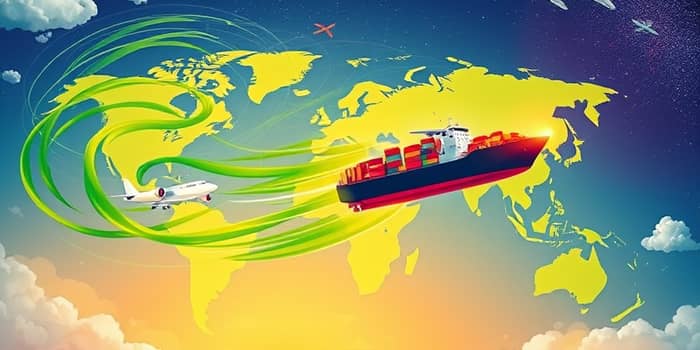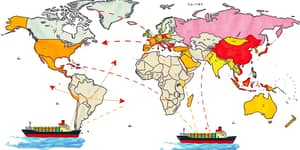
The European Union's ambitious climate agenda is no longer confined to its borders. Through the expansion of the Emissions Trading System (ETS), the rollout of the Carbon Border Adjustment Mechanism (CBAM), and the stringent inclusion of aviation emissions, the EU is imposing a transformative burden on global supply chains. Logistics providers find themselves at the heart of this transition, balancing cost pressures with the need to innovate and remain competitive.
Yet amid the complexities lies an opportunity to redefine logistics for a zero-carbon era. By embracing sustainable practices, leveraging cutting-edge technologies, and forging strategic partnerships, companies can transform regulatory challenges into engines of growth. This article guides you through the latest policy developments, practical responses, and inspiring success stories to help your organization thrive in an evolving carbon-constrained world.
From 2024 to 2026, shipping lines will move from covering 40% of emissions in the ETS to 100%. This rapid escalation turns carbon allowances into one of the fastest-growing cost centers for maritime operations. Early analyses show that surcharges tied to the ETS may nearly double year-on-year in 2025, pressuring shippers to absorb or renegotiate these fees.
Low-carbon bunker fuels and advanced emission abatement technologies further compound expenses. Airlines covering intra-EEA flights also face increased allowance prices, which get passed on to passengers and freight clients. CBAM adds another layer by requiring importers of iron, steel, cement, aluminium, and other energy-intensive products to purchase certificates for embedded emissions, adding an extra duty on top of traditional import levies.
Practical tip: Begin by conducting a thorough carbon cost audit to map your current exposure. Renegotiate carrier contracts to include transparent ETS surcharge breakdowns and explore long-term fuel hedging to stabilize budgets.
The push to decarbonize is prompting carriers and shippers to rethink routing, timing, and fuel sourcing. Some operators test alternative gateway ports outside the EU mainland, seeking to bypass the highest fees. Others invest in onshore power supply (OPS) infrastructure, reducing berth emission charges when anchored at major hubs. Port readiness varies widely, meaning careful partner selection is critical to avoid unexpected bottlenecks.
Forward-looking teams leverage data-driven decision-making and real-time monitoring to optimize vessel speeds and minimize idle time. Digital twins and carbon analytics platforms allow planners to simulate emissions profiles under different operational scenarios, identifying the most cost-effective and compliant routes.
To implement these strategies effectively, assemble a cross-functional task force blending operations, finance, and sustainability experts. Regularly review performance metrics and refine protocols to capture cost savings and emissions reductions in parallel.
Compliance goes far beyond simply settling carbon bills. The expanded ETS and CBAM frameworks introduce complex monitoring, reporting, and verification (MRV) protocols. Companies must track CO2, methane, and nitrous oxide emissions on a granular level, submit periodic reports, and retain audit trails. Missed deadlines or inaccuracies can trigger steep fines and reputational damage.
Non-EU exporters face additional hurdles. They must navigate unfamiliar registry systems to calculate the precise number of CBAM certificates required for different product categories. This can involve in-depth lifecycle assessments of raw materials, manufacturing processes, and transportation legs.
Partnering with specialized consultants and digital audit firms can dramatically reduce internal workloads. Implementing centralized emissions management software not only streamlines data entry but also offers predictive analytics to forecast certificate needs and budget for future compliance costs. streamlined global carbon management platforms deliver efficiency gains by aligning cross-border data silos.
Industry leaders are turning compliance costs into innovation catalysts. Deploying dual-fuel vessels running on ammonia or hydrogen, retrofitting existing ships with advanced scrubbers, and experimenting with wind-assisted propulsion can unlock significant fuel savings over time. These investments also signal to customers and regulators a genuine commitment to sustainable operations.
Technologies like digital twins, IoT-enabled sensors, and AI-driven route optimization create predictive models for fuel usage and emissions. They enable quick adjustments to voyage plans, ensuring proactive stance on sustainable supply chains by minimizing carbon hotspots before they escalate into compliance breaches.
Securing green financing through sustainability-linked loans, green bonds, or EU innovation grants can ease the upfront capital burden. For instance, issuing a green bond tied to decarbonization milestones aligns investor returns with environmental outcomes, creating a shared incentive to meet ambitious targets.
The complexity of global carbon regulations underscores the need for collective action. Industry consortia can co-develop common reporting frameworks, shared digital infrastructure, and interoperable compliance tools. Collaboration with port authorities accelerates OPS deployment and fuels infrastructure upgrades, laying the groundwork for broader sector decarbonization.
Engaging with policy makers through public-private dialogues ensures regulatory evolution remains pragmatic and informed by operational realities. Companies can use working groups to highlight challenges such as port capacity constraints or data standardization issues, shaping future phases of CBAM and ETS expansion.
Moreover, joining international initiatives like the Global Logistics Emissions Council (GLEC) or the Science Based Targets initiative (SBTi) elevates credibility and unlocks knowledge-sharing networks. By benchmarking against peers and sharing best practices, organizations build global supply chain resilience that withstands evolving carbon landscapes.
Below is a consolidated overview of major EU frameworks and their impacts on logistics.
While the path forward may seem daunting, EU carbon policies can catalyze transformation across the logistics industry. By integrating transparent reporting, operational optimization, and bold decarbonization projects, companies not only comply with regulations but also gain competitive advantage.
Embrace agility, foster collaboration, and invest in innovative technologies. This is your chance to pioneer sustainable logistics solutions and shape a resilient, carbon-neutral future. The journey toward continuous improvement in carbon management starts today, ensuring your organization thrives in an era defined by environmental responsibility.
References













